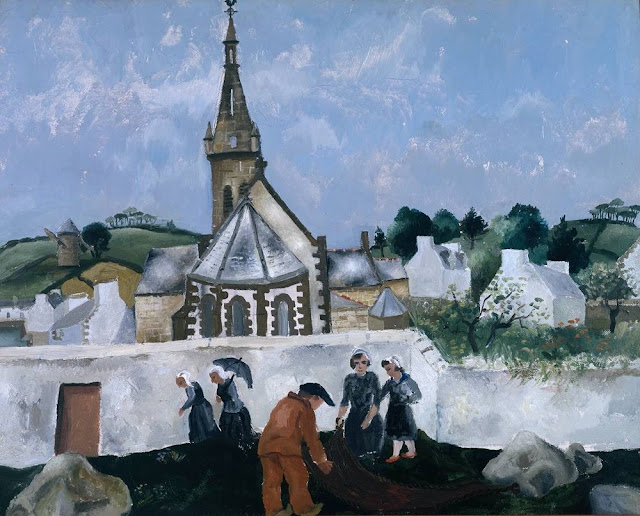![]() |
| Christopher Wood, Breton Woman at Prayer, 1930 (Southampton City AG) |
A new travelling exhibition at the
Norwich Castle Museum looks anew at the life and work of Christopher Wood (1901-1930) by hanging his pictures alongside those of his friend Cedric Morris (1889-1982). Their lives were a study in contrast. Wood was charismatic, flawed, driven and something of a genius; an opium addict, he died at the age of 29 when he fell under a train at Salisbury station. It is altogether in keeping with the contradictory nature of his life and career that no-one can be sure whether he jumped or fell. Morris, on the other hand, lived to a ripe old age and was a highly respected teacher. Lucien Freud painted his portrait. He was a good painter, but lacked the mysterious something that separates the great from the good.
![]() |
| Christopher Wood, Church at Treboul, 1930 (Tate) |
This greatness is something you feel (and it's subjective, of course). Sometimes when you read a story, watch a film or look at a picture you sense that there is something going on beneath or beyond the surface, and you keep coming back to experience that feeling again or in an effort to understand it better. Novels come larded with notes to help you understand imagery, hidden themes, structural tricks, etc; these may help you understand the techniques in use, without explaining why this particular story has such emotional power over you.
![]() |
| Cedric Morris, Breton Landscape, 1927 (Kirklees Museums and Galleries) |
I've read some books ('The Great Gatsby', 'The English Patient', 'Le Grand Meaulnes') over and over, with new excitement each time. And the same goes for pictures. I could stand all day looking at Gainsborough's portrait of
his daughters chasing a butterfly (a painting the artist apparently didn't rate very highly). Paul Nash's
'Event on the Downs' is always somewhere in the back of my mind. One or two of
Peter Doig's pictures keep me awake at night...
When Christopher Wood died he was about two years into his career as a painter of vision. Two years! Between 1928 and 1930 he painted like a man possessed, producing the famous pictures of Cornish fishing boats and Breton churches, and those other strange coastal paintings of sleeping sailors and sunbathers and drying fishing nets; there were other, more disturbing pictures too, such as 'The Yellow Man', which I think he painted in Paris.
![]() |
| Christopher Wood, The Yellow Man |
Unfortunately his life story has become tangled up with that of Ben Nicholson and Alfred Wallis, so that we tend to see him through the filter of that 1928 meeting in St Ives and dwell on questions of influence that detract from the real story. He may have borrowed Wallis's dark dark seas (the naive style he had already), but what he found in the Cornish and Breton fishing villages was something deeper. Sometimes he made his thoughts and feelings visible - in the skeletal timbers of a half-built boat, for instance - but on other occasions they are more elusive. In one picture a woman is mending a fishing net; another shows a woman praying in a simple church. The style is a bit heavy-handed, even clumsy (Morris was more technically skilled), yet there is in these pictures sadness and beauty, serenity and strangeness.
![]() |
| Christopher Wood, Pony and Trap, 1930 |
Some artists who die young seem already to have given us everything, artistically speaking, that they have. Christopher Wood, by contrast, was just getting started.
'Cedric Morris and Christopher Wood: a Forgotten Friendship' is at the Norwich Castle Museum until New Year's Eve, before touring to the Mascalls Gallery and the Falmouth Art Gallery. It is a Mascalls Gallery touring show, curated by Nathaniel Hepburn.




